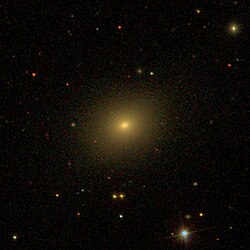NGC 7500
| Galaxie NGC 7500 | |
|---|---|
 | |
| SDSS-Aufnahme | |
| AladinLite | |
| Sternbild | Pegasus |
| Position Äquinoktium: J2000.0, Epoche: J2000.0 | |
| Rektaszension | 23h 10m 29,8s [1] |
| Deklination | +11° 00′ 44″ [1] |
| Erscheinungsbild | |
| Morphologischer Typ | S0[1] |
| Helligkeit (visuell) | 13,6 mag[2] |
| Helligkeit (B-Band) | 14,6 mag[2] |
| Winkelausdehnung | 2,1' × 1,1'[2] |
| Positionswinkel | 125°[2] |
| Flächenhelligkeit | 14,4 mag/arcmin²[2] |
| Physikalische Daten | |
| Rotverschiebung | 0,035418 ± 0,000103[1] |
| Radialgeschwindigkeit | (10.618 ± 31) km/s[1] |
| Hubbledistanz H0 = 73 km/(s • Mpc) | (481 ± 34) · 106 Lj (147,6 ± 10,3) Mpc [1] |
| Durchmesser | 295.000 Lj[3] |
| Geschichte | |
| Entdeckung | Lewis Swift |
| Entdeckungsdatum | 8. August 1886 |
| Katalogbezeichnungen | |
| NGC 7500 • UGC 12399 • PGC 70620 • CGCG 431-008 • MCG +02-59-004 • 2MASX J23102978+1100441 • GALEXASC J231029.71+110042.8 | |
NGC 7500 ist eine linsenförmige Galaxie vom Hubble-Typ S0 im Sternbild Pegasus am Nordsternhimmel. Sie ist schätzungsweise 481 Millionen Lichtjahre von der Milchstraße entfernt und hat einen Durchmesser von etwa 295.000 Lichtjahren.
Im selben Himmelsareal befindet sich u. a. die Galaxie NGC 7519.
Das Objekt wurde am 8. August 1886 von Lewis Swift entdeckt.[4]
Weblinks
Einzelnachweise
Auf dieser Seite verwendete Medien
Autor/Urheber: Sloan Digital Sky Survey, Lizenz: CC BY 4.0

Angle of view: 4' × 4' (0.3" per pixel), north is up.
Details on the image processing pipeline: https://www.sdss.org/dr14/imaging/jpg-images-on-skyserver/